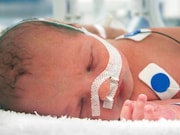Findings strongest among very preterm infants with respiratory distress syndrome ready for extubation
WEDNESDAY, May 8, 2019 (HealthDay News) — Nasal high-frequency oscillatory ventilation (NHFOV) reduces reintubation by more than 50 percent in preterm infants with respiratory distress syndrome (RDS), according to a study published in the April issue of CHEST.
Long Chen, M.D., Ph.D., from Children’s Hospital of Chongqing Medical University in China, and colleagues evaluated whether NHFOV could reduce intubation and partial pressure of carbon dioxide (PCO2) levels versus nasal continuous positive airway pressure (NCPAP) during the postextubation phase in 206 preterm infants (<37 weeks of gestation). The majority of infants (61.7 percent) were diagnosed with RDS, 25.7 percent with acute RDS (ARDS), and 12.6 percent with both.
The researchers found that NHFOV significantly reduced the reintubation rate (16:87 versus 35:68), particularly among infants with a gestational age of ≤32 weeks (12:34 versus 25:20), compared with NCPAP. In the NHFOV group, the PCO2 level was also significantly lower than in the NCPAP group. NHFOV significantly reduced the reintubation rate in preterm infants with ARDS (10:33 versus 21:15).
“Usually, one of the most important causes of reintubation is difficulty in clearing the partial pressure of carbon dioxide,” a coauthor said in a statement. “We found that NHFOV was superior to NCPAP in reducing PCO2 levels.”
Copyright © 2019 HealthDay. All rights reserved.








